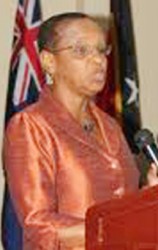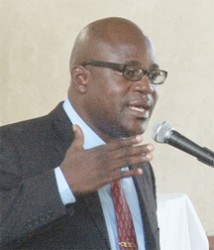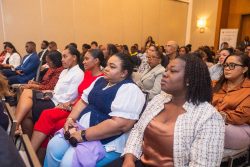There are signs of youth gang culture among a “small but significant” number of students in Guyana’s schools, Chief Education Officer Olato Sam said yesterday.
Addressing a small gathering of teachers, social workers and faith and community-based leaders at a workshop on the implementation of prevention strategies and actions to address youth gang and violence, Sam said that the Education Ministry has also noted the increase in gang-related incidents in schools. And the National Commis-sion on Law and Order, he added, recently signalled its concern over the “increasing number of reports of youth involvement in gangs that commit crime and violent acts.”
“The Ministry of Educa-tion has noted the increase in reported gang-related incidents in our institutions. It is of concern that a small, yet significant number of students, have begun to demonstrate behaviours that mirror the formation of a youth gang culture,” he told the participants at the workshop, while noting that strategies to address the situation are of critical national and regional importance and welcoming the broad-based, multidisciplinary and multi-sectoral approach being adopted towards this end.

At the national level, Sam said, the emergence of this phenomenon has led to strategies aimed at lessening the potential impact on the school environment being implemented. He noted that the first to commence was the development of a protocol for safe and secure schools, which is a comprehensive guide for school managers on ways to foster and maintain safe school environments. This strategy, he said, emerged from the ministry’s recognition that there was a lack of knowledge as to what factors were directly contributing to youth gang culture. The commencement of this strategy, he further said, was also based on the absence of systematic approaches to dealing with gang-related incidents in schools.
The role and scope of the ministry’s Schools’ Welfare and Guidance and Counselling Unit, he also noted, has been expanded as has collaboration with the Ministry of Labour, Human Services and Social Security so as to maximise the impact of their collective resources. Sam said that through support from UNICEF, health and family life education has now been effectively integrated into the curricula of primary and secondary schools.
He added that through the funding received, the Tackle project within the ministry is currently targeting over 3,500 secondary students. This programme, he explained, is aimed at fostering behavioural change through sustained mentoring of students, parenting education and empowerment counselling and life skills training.
In addition, he said the Schools’ Welfare Unit has started the process of tracking critical incidents in schools to provide “an empirical framework from which sound policy initiatives and key interventions could be devised.” This, he added, is being strengthened by two system-wide surveys already conducted by UNICEF and the Alabama State University, aimed at effectively identifying Guyana’s most At-Risk youth and their behavioural patterns. He was optimistic that this would greatly assist the ministry in understanding the nature of the problem within the local context, but more importantly it will assist the ministry and its stakeholders in “being more pro-active, preventing these critical incidents rather than merely reacting to them.”
The training workshop is one of the follow-up activities under the Caricom Youth Gangs and Violence: Partner-ing for Prevention and Social Development Project. It is being piloted in Guyana and four other Caricom member countries. The project is receiving support from the United Nations Development Programme (UNDP). The workshop, which is the third national engagement in Guyana, is being held at the Grand Coastal Inn and will run until Friday.
Regional problem
Myrna Bernard, Officer in Charge of the Directorate of Human and Social Develop-ment at Caricom, said that awareness of the alarming escalation of violence in the entire Caribbean has become more acute recently.
“The increasingly disturbing trend of the involvement of our youth as both victims and perpetrators of violent crimes must give us reason to pause and to search for answers which will hopefully guide us to solutions,” she said, while adding that newspaper headlines highlight the seriousness of the situation.

In 2005, she said, the Caribbean Commission on Health and Development flagged violence and injuries as one of the three issues with significant implications for development if not specifically addressed. Since then, she said, the prevalence of violence and injuries in Caricom member states has escalated to the degree that it has become not only a public health problem but also a priority regional security and development issue.
Bernard also reported that according to the UNDP Caribbean Development Report for 2012, school-age youth become involved in gangs from as young as 12. A study of 2,300 school-aged youth in Trinidad and Tobago found that most joined for reasons relating to friendship (42 percent), and protection or safety (29.4 percent), while the remainder joined because a family member was in a gang (5.9 percent), to make money (8 percent), or for other reasons (14.7 percent).
“These statistics on crime and violence, and in particular data on youth crime and violence, indicate that the situation in the Caribbean is more that a perception, it is certainly a reality for many of the young people across the region who indicated to [the] Caricom Commission on Youth Development in 2009 that crime and violence was their ‘number one concern,’” she said.
Bernard added that there are many contributing factors to youth violence and gang crimes and among those that she listed were inadequate and poor parenting; the receding influence of institutions such as schools and faith and community-based organizations; high levels of youth unemployment; exposure to and experience of violence at home, in school, in communities and the wider society; poor or inadequate educational opportunities; and social exclusion.
Addressing risks
Meanwhile US Ambassa-dor Brent Hardt stated that the workshop continues a timely and strategic Caricom intervention in Guyana and other Caribbean countries to tackle head on the emergence of youth gangs and related violence. “I am confident that the ideas presented and the open exchange of views will lead to even more effective project implementation and targeted strategies to combat the scourge of youth gangs and the violence that surrounds them,” he said.
Hardt noted that the US shares Caricom’s belief that it is vital to the region’s future to ensure a better future for young people. He recalled that in the budding stages of the Caribbean Basin Security Initiative (CBSI) partnership, “we heard from leaders throughout the Caribbean that they worried about youth and were uncertain how to counter the slide into violent behaviour.” He recalled a meeting with Secretary General Irwin LaRocque during which concerns were emphasised that the region risked losing a generation if more was not done.
“If we are to achieve this goal, we have to grapple with a number of manifestations of the risks facing Caribbean youth, including lack of economic opportunity, job skills, and life skills, the interaction between young people and the judicial system, and the reality of life on the streets and in villages,” he said, while adding that it is in dealing with the daily social pressures, temptations, and criminal environment that this Caricom project is so critical.
By identifying the risk and protective factors of at-risk youth within the Caribbean, he stressed, successful programmes can be built to contribute to national and regional strategies to address the root causes of youth gangs and violence.
He said to help address some of the other key youth risk factors, the CBSI partnership has sought to develop initiatives and undertake actions in complementary areas.
The Ambassador pointed out that in Guyana, the USAID Skills and Knowledge for Youth Employment (SKYE) project has been working with an array of local partners to reduce youth violence by strengthening youth participation in economic activity and increasing their engagement in society. “Already through the SKYE project, 122 at-risk youth have graduated from a work readiness curriculum and have been linked with mentors to guide them on a path to employment and opportunity,” he said, while adding that in this effort, the private sector has been an enthusiastic partner in helping identify where jobs can be found and being willing to take a chance on a SKYE graduate.
Recognising that one of the most effective approaches to reducing youth crime and violence is to concentrate on rehabilitation and second chance opportunities for troubled youth, SKYE, he said, has also been working with young offenders and the courts to promote alternative sentencing programmes and to facilitate successful reintegration. “Again, we have already seen dozens of cases where young Guyanese have been able to take advantage of SKYE’s alternatives rather than be sentenced to terms in prison, where they may have become more hardened in their outlook,” he told the gathering, while expressing satisfaction that these initiatives are taking root and making a difference in the lives of Guyanese youth.
Head of the European Union Delegation Robert Kopecky and the Manager of the UNDP Governance Programme in Guyana Trevor Benn also spoke to the seriousness of the issue and contributing factors, including the global economic crisis.
A summary of the findings of youth gangs and violence in the Caribbean, understanding the problem, the risks and resilience and developing strategies and actions, will be some of the topics that would be explored and discussed over the next three days.





